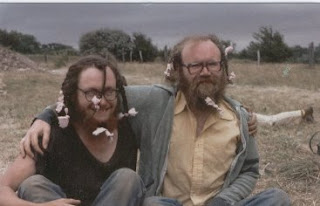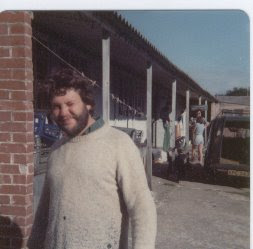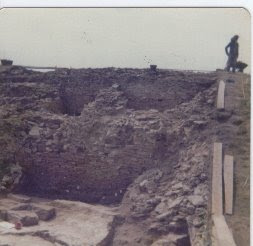I have received the following appetiser from Dr Ferris, edited slightly before publication to protect the innocent: "... I have two excellent pictures that would enhance Crickley Hill Man's current gallery ... but they are colour slides- do you have the wherewithall to deal with these? [Not yet: Ed - but it sounds as though finding the technology might prove worth our while, as I bet these aren't the only slides Iain's got] One shows a young Parker digging, resplendent in collarless white shirt, black waistcoat and dark serge army trousers with red material strip down the outer legs. Given our absurd obsession with novel clothing during one or two of the seasons it's a wonder we ever found time to fit in some digging. The other slide, again notable for its sartorial eccentricity, shows Phil driving a dumper truck while dressed in a brown velvet or corduroy suit - had he caught the dressing-up bug as well? ... last Saturday was most enjoyable: it would be good to see more diggers in 2009- hopefully your blog will bring them in." Let's hope you're right - I will liaise with Iain to see how we can get these (and other) slides into an electronic edition. PS: I recall that the cavalry trousers were acquired for a very modest sum from the Cheltenham Oxfam shop. In those days, it was a splendid place to acquire dinner jackets and parts of dress uniforms, probably because, as the retired military officers who lived in Cheltenham died, their widows and housekeepers sent their clothes to the Oxfam shop. |
Thursday, July 31, 2008
Dr Ferris writes ...
Labels:
Cheltenham Oxfam Shop,
Dixon,
Dumper trucks,
Ferris,
Parker
Enchanting vision ...
Wednesday, July 30, 2008
Cutting AXV Rear August 79 ...
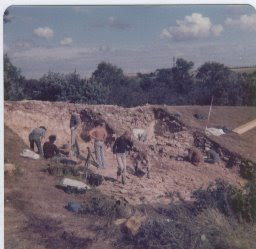
Left to right: Terry Courtney, Philip Dixon, Mark Spivakovski, Paul Noakes, Sarah Stevens, Nina Stoyan, Richard Potts, Mike Taylor and Anna Collinge.
Monday, July 28, 2008
A contrasting view of Messrs. Courtney & Boden ...
Ullenwood, almost the same view but nearly 30 years ago ...
Ullenwood...
Sunday, July 27, 2008
References to Crickley in the proceedings of the House of Lords
I have unearthed a couple of intriguing 18th century references to highway or road "from the top of Crickley Hill" in Acts of Parliament:
Main Papers (Parchment Collection) HL/PO/JO/10/2/26 12 May 1702-15 Dec 1704
5 Feb 1703/04 - Engrossment of an Act for repairing the highways between Royston and Caxton, Cambridgeshire, and for the Highway from Birdlip and the top of Crickley Hill, Gloucestershire, to Gloucester (NS V no 1983).
Main Papers (Parchment Collection) HL/PO/JO/10/2/47 9 May 1759-24 May 1762
22 May 1759 - Act to amend an act of 24 George II as relates to the road leading from the top of Crickley Hill in Gloucester to the utmost extent of the said county.
Main Papers (Parchment Collection) HL/PO/JO/10/2/26 12 May 1702-15 Dec 1704
5 Feb 1703/04 - Engrossment of an Act for repairing the highways between Royston and Caxton, Cambridgeshire, and for the Highway from Birdlip and the top of Crickley Hill, Gloucestershire, to Gloucester (NS V no 1983).
Main Papers (Parchment Collection) HL/PO/JO/10/2/47 9 May 1759-24 May 1762
22 May 1759 - Act to amend an act of 24 George II as relates to the road leading from the top of Crickley Hill in Gloucester to the utmost extent of the said county.
A review from the Hendon & District Archaeological Society of their visit to Crickley in 1976
The August Outing – To Cotswold Country
By Vincent de Paul Foster.
We were met at the entrance of the outer ramparts by Philip Dixon, Lecturer in Medieval Archaeology at Nottingham and Director of the Crickley Hill excavations. After explaining the layout of the fort, he told us its history. The site was occupied during both Neolithic and Bronze Ages, and is in area of approximately 3.6 hectares, enclosed by a ramparts rising to 2.7 m at the east end, with a ditch some 2.4 m deep. The other sides are so steep that additional defences there were unnecessary.
The earliest defences were constructed in the 6th/5th centuries BC of timber lacing. This method, also usable with stone revetting, obtains maximum strength by securing horizontal cross timbers through the body of the rampart, with connecting vertical posts at front and rear. This rampart was destroyed by fire. The northern entrance, in the last phase of construction, consisted of stone bastions with an enormous curving defensive hornwork.
Inside the fort Iron Age longhouses, unique to this country, have been excavated. The more common roundhouses have also been found. There are also 2 sets of Neolithic ditches; the earlier is of the usual causewayed camp type, with interruptions. The later is continuous and deeper than usual with a bank behind it. This season's 5-week dig has about 100 volunteers, mostly very youthful. We ate our lunch at the outer ramparts, and were startled to watch, from a distance, the mad rush of diggers to their lunch, at the nearby Civil Defence camp, as soon as klaxon sounded. Philip Dixon had warned us of his daily stampede, but I thought he was joking. British Olympic Selection Committee, 1980, please note -- this is a hot-bed of potential 3 1/2 minute milers.
Labels:
Crickley,
Dixon,
Hendon and District Society,
Longhouses,
Roundhouses
Cuttings AA6, A6, B6, AA5 and A5,1979

Top: cutting AA6, August 1979, Chris Phillpotts, who has noticed the photographer, sagely tugging his beard to make it appear that thought processes are occurring, whilst Ros Cleal and Sarah Roberts discuss what to do next.
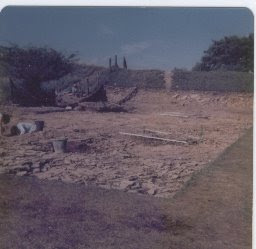
Middle: cuttings AA6, AA5, A6, B6 and A5, August 1979, Ros Cleal just discernible up by the rampart beyond the fence that divides the Council land from that of the National Trust.
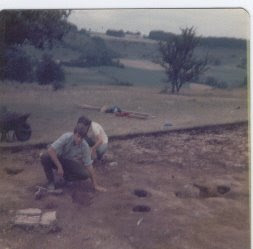 Bottom: cutting A6 looking across the National Trust side towards Birdlip: Dave Southwood and Marion Barter examine some suspiciously coherent looking features.
Bottom: cutting A6 looking across the National Trust side towards Birdlip: Dave Southwood and Marion Barter examine some suspiciously coherent looking features.
Labels:
Barter,
Cleal,
Cutting A5,
Cutting A6,
Cutting AA5,
Cutting AA6,
Cutting B6,
National Trust,
Phillpotts,
Roberts,
Southwood
Party in 1979 - Chipper provided the scrumpy...
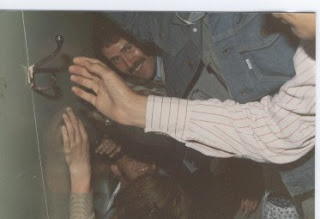

Party in Dorm 2 (correction: 4) in 1979. Two photos from this curious sequence, where the name of the game seems to have been to get as many people as possible of both sexes and any denomination into a single cubicle equipped, for the party alone, I seem to recall, with two single beds. Persons or part-persons that I can identify include in the top photo Randel Motkin (?), Marion Barter, me, Dave Southwood, Paul Noakes, JP. In the lower, Anna Collinge, Ros Cleal, Bernie Dawson, unknown, and Iain Ferris. Suspect this photo may have been taken by Dr Phillpotts.
CH sometime in early 80s

Rebecca Chambers resting against Phil's van: who's the man next to her? (Update: it is Graham Byron O'Hare) In the background you can just see, in its earliest years, the Courtney Memorial Platform which we discovered yesterday no longer graces the entrance. Its demise appears recent since the track up where the steps were is still easily visible.
CH 1979 - the rampart
Jim Irvine, Robert Roberts, John Howell and Max Glaskin dine together...

A lunch break, possibly summer 1979 [update: actually 1977], with unusual formal touches: bow tie, waistcoat, bottle of wine... and where on earth did the table cloth come from? Jim Irvine comments: "Hi Julian, That was in fact 1977, my first (training) excavation at Crickley. I remember the dinner well and still talk about it. IIRC the guy on the left with his back to the camera may have been Max Glaskin and the girl next to him our 'butler' was called Jane and hailed from the Wirral. Crickley Hill Man said... Oddly enough, Jim, I was just looking at the grass in the photo and wondering whether I was right about it being 79 because it looks dry enough to be 76. But I'm glad you know the answer. Max's surname had escaped me: I remember he had a rather fine and inevitably vulgar joke about Moshe Dayan and an ill-behaved parrot which cannot be repeated here as it is partly visual.
Saturday, July 26, 2008
Picnic time on the Hill
For the last few years a number of Crickley veterans have met up, usually on the first Saturday in August, for a picnic on the hill and to gaze at that unbeatable view.
We tend to meet at about 2 p.m. in the picnic area that now exists outside the rampart, enjoy the food and drink, catch up with what's happening in everyone's lives and then persuade Phil to take us on a walk round the hill and give us an update on his latest thinking and on where he's got to with the continuing labour of love that will one day result in publication.
Attendees have included Philip Dixon, Richard Savage, Lydia Savage, Terry Courtney, Iain Ferris, Chris Phillpotts, Jim Irvine, John Parry, Ros Cleal, Corky Gregory, Jenny Tinker, Steve Vaughan, Joanne Vaughan, Rebecca Chambers, Paul Noakes, Arwel Barrett, Malcolm White & Julian Parker. There may well have been others that are missing from that list which is from memory.
We tend to meet at about 2 p.m. in the picnic area that now exists outside the rampart, enjoy the food and drink, catch up with what's happening in everyone's lives and then persuade Phil to take us on a walk round the hill and give us an update on his latest thinking and on where he's got to with the continuing labour of love that will one day result in publication.
Attendees have included Philip Dixon, Richard Savage, Lydia Savage, Terry Courtney, Iain Ferris, Chris Phillpotts, Jim Irvine, John Parry, Ros Cleal, Corky Gregory, Jenny Tinker, Steve Vaughan, Joanne Vaughan, Rebecca Chambers, Paul Noakes, Arwel Barrett, Malcolm White & Julian Parker. There may well have been others that are missing from that list which is from memory.
4 July 2009
Saturday 4th July 2009 marks the 40th anniversary of the beginning of the archaeological excavations at Crickley Hill in Gloucestershire. More than 3,000 volunteers from all over the world worked on the site between 1969 and 1994 - 25 successive seasons of digging.
The excavations were directed throughout by Dr Philip Dixon, former Reader in Archaeology at the University of Nottingham. The Secretary to the excavation was Richard Savage.
It is proposed that there should be a reunion to mark the 40th anniversary of the excavations and this blog has been created to allow the many people who worked at Crickley over the years to find out about, plan and participate in the reunion.
The excavations were directed throughout by Dr Philip Dixon, former Reader in Archaeology at the University of Nottingham. The Secretary to the excavation was Richard Savage.
It is proposed that there should be a reunion to mark the 40th anniversary of the excavations and this blog has been created to allow the many people who worked at Crickley over the years to find out about, plan and participate in the reunion.
Subscribe to:
Posts (Atom)




